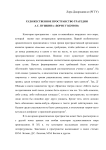Статьи журнала - Новый филологический вестник
Все статьи: 1746
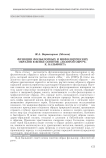
Функции фольклорных и мифологических образов в венке сонетов "Золотой обруч" К. Бальмонта
Статья научная
Цель статьи рассмотреть функционирование фольклорных и мифологических образов в цикле стихотворений Бальмонта «Золотой обруч», который является частью книги «Мое ей» (1923). В статье выделяется три категории фольклорных и мифологических образов это образы драгоценных камней и металлов, растительные образы и образы народной жизни (атрибутика календарно-обрядового фольклора). Научная новизна исследования определяется фокусированием внимания на том, какие смысловые возможности открываются для поэзии, обращающейся к жанровой форме сонета, включающего в себя фольклорные и мифологические образы. Это, прежде всего, возможность поделиться с читателем своим взглядом на цикличную природу бытия, реставрировать мифы народной жизни, филигранно соединяя их с личными переживаниями лирического героя. Полученные результаты исследования показали, что жанровая форма сонета выбрана поэтом не случайно она позволяет причудливо соединять образы природной жизни, призванные отразить глубину представлений человека о жизни и смерти, воспроизвести мир как соединение вещественного и невещественного, бытового и бытийного. В венке сонетов гармонично соседствуют образы календарно-обрядовой поэзии, отсылки и аллюзии к библейским сюжетам и образам. Проявляя христианское смирение перед Господом, лирический герой Бальмонта видит истину в образе жизни древнего славянина, знавшего магическую силу драгоценных металлов, камней, деревьев, трав, воспринимавшего дары природы и земли как настоящий клад, сокровищницу народа, и следовавшего ритму народной жизни (народному календарю, праздникам, народному быту).
Бесплатно

Функциональная роль места и времени в классицистической трагедии ("Софонисба" Ж. Мерэ)
Статья научная
Цель данной статьи - показать особенности трактовки Жаном Мерэ драматических законов «Поэтики» Аристотеля, рассмотреть характер функционирования категорий времени и пространства в трагедийном действии «Софонисбы» и их роль в построении драматической структуры. Доказывается, что место и время в трагедиях Мерэ являются не только формальными признаками «правильной» драмы, но активно функционируют на содержательном уровне, то есть играют организационно-смысловую роль (подчеркивают логику разворачивания действия, участвуют в композиционной связи, раскрытии характеров и эмоциональных состояний персонажей, определяют зрительское восприятие). Большое значение играет эффект акцентируемого в авторских ремарках и высказываниях героев замкнутого (интимного, вторжение в которое получает значение угрозы, насилия) пространства, которое к развязке может изменять свое значение: от убежища, места любви и уединения - до тюрьмы, места суда и расправы («Софонисба»). Показывается, как Мерэ создает эффект стягивания времени, что усиливает трагедийную напряженность - внешнюю (обстоятельства и поступка) и внутреннюю (характера и страсти), обеспечивает ощущение катастрофичности происходящего, неотвратимости гибели. Выводы позволили показать, как экспериментирование Мерэ с местом и временем в драматическом действии способствовало обновлению французской трагедии в первой половине XVII в. и предопределило специфику построения пьес Корнеля и Расина.
Бесплатно

Статья научная
Одной из актуальных проблем поэтики эпического сюжета является рассмотрение мотивов как слагаемых элементов сюжетной системы. Целью настоящего исследования является изучение функционально-семантических особенностей ряда типических мотивов в сюжете синьцзян-ойратской версии эпоса «Джангар». В ходе исследования выявлено, что в эпосе имеется устойчивый и повторяющийся арсенал типических мотивов, функционирующий в составе системы и находящий свое определенное место в структуре сюжета. Анализ выявил ряд важных функциональных и семантических особенностей типических мотивов (пира, получения вести / послания, совета, поимки коня, седлания коня, снаряжения героя, отправления в путь героя, преодоления пути, сражения / поединка) в контексте эпического сюжета. Мотив пира обрамляет эпический сюжет и носит характер отправного элемента в его развитии. Мотивы вести / послания и совета имеют прагматическую функцию, от которой зависит дальнейшее развитие сюжетных событий. Устойчивая цепочка мотивов поимки коня - седлания коня - снаряжения в путь героя - отправления в путь героя играет организующую роль в сложении сюжета, а мотив сражения / поединка имеет сюжетообразующее значение. Несмотря на тематическое разнообразие и вариативность, мотивы обнаруживают типические свойства на структурном и содержательном уровнях, очевидна их универсальная модель построения и развертывания мотивов. Типические свойства характеризуются определенными релевантными признаками и маркирующими элементами, где важную роль играют облигаторные акторы, локусы, темпоральные признаки, эпические хронотопы и хроноакты. В семантике типических мотивов находят отражение архаическая символика и мифология, традиционные этнические ритуалы, обряды и верования, история и быт монгольских номадов, а также эпические концепты.
Бесплатно
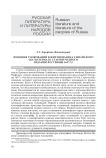
Функция толкований в житии Иоанна Синайского (на материале старопечатного издания Лествицы 1647 г)
Статья научная
Статья посвящена изучению роли толкований (схолий), принадлежащих тексту Краткого жития Иоанна Синайского, составленного монахом Даниилом Раифским. Анализ проводится на материале первого русского издания Лествицы 1647 г. Оно было подготовлено известным книжником XVII в. Сергием Шелониным, который текстологически изучил и отобрал толкования из разных источников. Всего в Житии находится четырнадцать толкований, которые визуально располагаются внутри текста Жития сразу вслед за толкуемым фрагментом, что обусловливает необходимость их изучения в контекстно-текстовой связи. Рассматривается их смысловая и формальная связь с топосами Жития и его сюжетно-композиционной структурой. Главная цель схолий - разъяснение читателю смысла конкретных фрагментов текста Жития, которые представляют, как правило, ключевые топосы. Анализ смысловых корреляций толкований и Жития с учетом общей структуры текста позволяет сделать вывод о трех основных функциях толкований. Первой и определяющей является функция агиографическая, присущая большинству толкований, направленных на разъяснение содержания подвига святого и его образа. Второй своей задачей толкователь видел поучение, и в трех толкованиях доминируют черты проповеди. Третья, стилевая функция, определяется стремлением толкователя идти вслед за стилем агиографа. В целом отмечается связь толкований со структурой жития «биос» и одновременно влияние панегирического стиля. При этом наблюдается некоторая стилевая и функциональная неоднородность толкований, которая свидетельствует об их принадлежности разным авторам. Главной же является смысловая роль схолий в отношении к Житию, углубляющая понимание читателем его духовного содержания.
Бесплатно
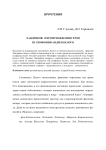
Хандриков: о происхождении героя III симфонии Андрея Белого
Статья научная
Несмотря на выдающуюся способность Белого к ономастическому гротеску, фамилия Хандриков ничего собой не представляла ни с точки зрения аллегорической, ни звукоподражательной. Русский астроном Митрофан Хандриков был коллегой отца Андрея Белого, Н.В. Бугаева. Хандриков написал о периодичности метеорных потоков, что стало одним из основных символов «III симфонии» Белого. Такой прообраз главного героя в «декадентской» Симфонии может определить наше понимание отношений между двумя поколениями: старшего - академического, и младшего - декадентского.
Бесплатно

Характер историзма эпоса "Джангар" сквозь призму сюжета
Статья научная
Идеи и опыт «русской школы исторической поэтики», основанные на исторической компаративистике и закономерностях ментальной эволюции человека, актуальны в изучении эпических произведений национального фольклора. В статье рассматривается актуальная проблема исследования характера историзма эпоса «Джан-гар» сквозь призму содержания и семантики сюжетов, что позволяет проследить исто-рическую и эстетическую динамику национального эпоса. В результате автор приходит к выводу, что на сложение и формирование джангаровской эпической традиции оказали влияние социально-исторические факторы патриархально-родового и феодального строя. Патриархально-родовые связи и отношения, а также инициационная ритуальность и обрядовость находят отражение в сюжетах «Джангара» о героическом сватовстве. Сюжеты же о борьбе героя с хтоническим существом и антагонистом относятся к героическому эпосу исторического времени, к периоду формирования ранних кочевых государств и выдвигает новые исторические идеалы и новые цели - защиты родной земли от внешнего врага. Характер историзма эпоса «Джангар» и его сюжетов обусловлен тем, что корнями он уходит в архаический субстрат древнейшей мифологии и шаманистских верований; эпос развивался в условиях распада родовых отношений и перехода от рода к семье, в период зарождения государственного самосознания и формирования ранних государств. Смена исторических эпох отразилась в сюжетах эпоса «Джангар», вобравших как архаические религиозно-мифологические и обрядовые рудименты, так и определенные исторические и квазиисторические представления. Эпос «Джангар», обладающий полистадиальной природой, наследует рудиментарно архаические черты на уровне сюжетов и мотивов и воссоздается на основе традиционных элементов по жанровым моделям и канонам, получив творческую переработку в новых исторических условиях.
Бесплатно

Хармс vs. нейрохармс: нейросеть как лаборатория нарратива
Статья научная
В статье поднимается вопрос о возможности использовать нарративы, созданные трансформерной нейросетью «Порфирьевич» на основе оригинальных авторских текстов, в качестве инструмента исследования общих закономерностей текстопорождения. Анализируются результаты эксперимента, направленного на выявление принципов, в соответствии с которыми нейросеть имитирует акт художественного творчества; устанавливается, что используемые нейросетью алгоритмы порождения нарративов вступают в значимые корреляции со стилистическими параметрами и нарративными стратегиями художественного дискурса. Исследование текстовых вариантов, созданных нейросетью в продолжение миниатюр Д. Хармса из цикла «Случаи», позволяет проследить, как изменение параметров текста-стимула оказывает влияние на выбор нейросетью разных нарративных стратегий - от простейшей грамматической имитации текста-стимула до его семантического достраивания на основе индексальных знаков исходного нарратива. Результаты проведенного эксперимента вскрывают потенциальную логику «нейронарратива», а также задают открытый набор потенциальных «неучтенных возможностей» нарративных технологий, из которых акт художественной креации выбирает лишь одну. Результаты текстопорождения, которые демонстрирует нейросеть, обученная на художественных текстах, могут быть рассмотрены как своеобразная модель творческого процесса, репрезентирующая максимально чистые, свободные от авторских валентностей технологии письма.
Бесплатно

Холод, мороз в поэзии Иосифа Бродского
Статья научная
В статье анализируются мотивы холода / мороза в поэзии Иосифа Бродского, имеющие, как показывает проведенное исследование, традиционно негативные коннотации, гипотетически восходящие в том числе к лирике американского поэта Р. Фроста, но переосмысленные Бродским в экзистенциальном ключе. Холод в его художественной системе не только связан с распадом чувства и образами смерти, но лишает поэта его идентичности, которая соотносится с жизнью, понимаемой как жизнь поэта - художника слова. Немногие исключения встречаются в основном в ранней лирике поэта («Рождественский романс», в некотором смысле «Почти элегия»). Однако в целом мотивы холода / мороза используются Бродским для выражения меланхолического отношения к миру, где отдельная личность подвергается опрессии. Для преодоления сложностей, связанных с комментированием семантически и функционально разнородных примеров, автор статьи предлагает рассмотреть несколько характерных текстов, пытаясь найти в них суть метафоры как поэтического эквивалента самых глубоких мыслей и эмоций. В ходе этого анализа обнаруживается, что мороз, похожий на время, - это один из центральных топосов произведений нобелевского лауреата, который позволяет Бродскому подчеркнуть роль эмоционального начала и субъективности в системе экзистенциальных ценностей, противопоставляемых объективности и невозмутимости внешнего мира по отношению к личности.
Бесплатно

Статья научная
В статье изучается рыцарская поэма неизвестного автора «Сэр Гавейн и Зеленый Рыцарь», написанная на северо-западном диалекте среднеанглийского языка приблизительно в 1330-1400 гг. как образец светской католической средневековой гомилетики. Цель работы - проанализировать христианские гомилетические особенности поэмы. На основе анализа «Сэра Гавейна» в рамках озвученной гипотезы показано, что поэма может быть представлена как пространство противостояния христианских (король Артур, сэр Гавейн, рыцари Круглого Стола) и языческих (Зеленый Рыцарь, Фея Моргана, леди Бертилак) сил. Показано, что религиозные смыслы поэмы тесно связаны с гендерными смыслами. Христианские смыслы «Сэра Гавейна» не лежат на поверхности, не прочитываются в тексте сразу же, а являются некоторым образом замаскированными, скрытыми в глубине текста в виде символов, загадок, коннотативных семиотических построений, связанных с темой гендерного конфликта. В рамках предложенной концепции центральным семантическим местом поэмы становится психологическая дуэль сэра Гавейна и леди Бертилак, которую можно трактовать как материализацию восстания мира темных оккультных сил на мир христианский, поскольку, по мнению самого сэра Гавейна, он поверил в магию, язычество и в то, что именно колдовство, а не Бог спасет его от неминуемой, как он считал, смерти. В статье с точки зрения христианской психологии проводится сопоставление внутреннего и внешнего понимания греха сэра Гавейна, при этом субъективное восприятие своего поступка героя намного серьезнее, чем трактовка с точки зрения общего католического подхода «сделанный грех - принесенное покаяние». Делается вывод, что исследование католической гомилетики как сюжетообразующего принципа «Сэра Гавейна» ценно эвристически и может служить средством открытия христианских смыслов и в других произведениях куртуазной средневековой литературы. Как показательный образец куртуазного рыцарского романа поэма «Сэр Гавейн и Зеленый Рыцарь» может являться поучительным примером светской католической гомилетики позднего средневековья.
Бесплатно
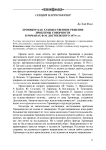
Хроникер как художественное решение проблемы соборности в романах Ф.М. Достоевского 1870-х гг.
Статья
В статье исследуются некоторые функции фигуры Хроникера в произведениях Ф.М. Достоевского, с акцентом на реализации идеи соборности.
Бесплатно
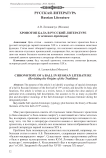
Хронотоп бала в русской литературе (к истокам традиции)
Статья научная
Цель статьи - выявить типологию частного хронотопа бала в русской литературе первой половины XIX в. и описать его основные сюжетные функции. Статья имеет обзорный характер, что исключает возможность подробного анализа отдельных произведений, содержащих бал, но предполагает фиксацию как можно большего количества возможных сюжетных и изобразительных значений данного хронотопа в литературе обозначенного периода.
Бесплатно

Хронотоп праздника в романе И.С. Шмелёва "Лето Господне": аксиологический аспект
Статья научная
Исследуются особенности пространственно-временной структуры праздника в романе И.С. Шмелева «Лето Господне». Утверждается, что хронотоп произведения отражает авторский темпоральный опыт, в котором индивидуальное сливается с национальным, и личностное приобретает архетипический характер, и разнообразные элементы внутреннего и внешнего миров сливаются в единое целое. Типологической основой темпорального опыта выступает чередование двух модусов бытия - будней, наполненных привычной трудовой деятельностью, и праздников, которые представляют собой изъятие из линейного течения повседневной жизни. Явление праздника, творчески и философски переосмысленное, составляет основу архитектоники произведения. Пространственно-временная организация праздника, в котором вечность врывается во время и становится «преобладающей силой» (Н.А. Бердяев), выступает формой актуализации ценностных приоритетов автора. Соотнесенный с Абсолютной ценностью в онтологическом пространстве веры, праздник осмысляется как идеально освященный. Праздник становится прообразом будущей полноты совершенства, символически приоткрывая логически непостижимый образ вечности, в которой уничтожаются темпоральные границы. Через молитвенное поклонение святой иконе, в которой невидимый мир становится «присутствующим, видимым и действующим» (В.Н. Лосский), преодолевается разделение между временным и вневременным, материальным и метафизическим. Делается вывод, что создаваемый И.С. Шмелевым образ праздника, в котором «быт насыщается бытием» (И.А. Ильин), представляет собой художественное выражение национальных идеалов - фундаментальных аксиологических моделей культуры.
Бесплатно

Хронотоп угрозы и ее метафорическое преодоление в российском интеллектуальном романе XXI в
Статья научная
Статья обобщает результаты исследования по междисциплинарному проекту РГГУ, разрабатывающему проблематику социокультурных угроз и вызовов современного общества в целом и типов угроз в современной интеллектуальной прозе XXI в., в частности. С литературоведческой точки зрения угроза и вызов исследуются прежде всего на уровне проблематики романа, выраженной ключевыми метафорами романов. В разделе «Парадокс современного восприятия: автор и его герой в мире-после-травмы» (Е.М. Луценко) анализируется проблематика трех современных романов («Зона затопления» Р. Сенчина, «Лавр» Е. Водолазкина, «Прыжок в длину» О. Славниковой). Несмотря на разность внешней (социальной) проблематики (экологическая катастрофа Сибири, неиклюзивность среды, общественные проблемы средневековой Руси), типологическое сравнение данных текстов представляется уместным благодаря внутренней (личностной) проблематике, выраженной рядом традиционных ценностных оппозиций, в которых смещено понятие нормы; данный сдвиг отражает парадокс восприятия, связанный с психикой человека в мире-после-травмы, и проявляет себя в этих романах одинаково, несмотря на различия хронотопа и жанровой установки. В разделе «Иллюстративная и когнитивная метафора в современном романе» (Е.А. Погорелая) актуальные угрозы исследуются в контексте их метафорического воссоздания, причем если иллюстративная метафорика (представленная в романах Э. Веркина, А. Геласимова и др.) позволяет лишь зафиксировать образ угрозы, то метафорика когнитивная (см. романы А. Иванова, К. Букши, М. Гиголашвили) дает наметить путь преодоления этих угроз.
Бесплатно
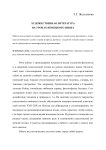
Художественная литература на уроках немецкого языка
Статья
Работа над поэзией на уроках немецкого языка имеет своей целью рассказать с помощью поэтического слова о стране и народе, развить у студентов чувство языка и умение вести дискуссию по анализируемому произведению.
Бесплатно
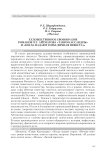
Статья научная
В статье рассмотрены художественные особенности произведений киргизского писателя Чингиза Айтматова, проанализирована история переводов и научных исследований его произведений. Прослежена эволюция авторского стиля: от психологизма ранних повестей к глубокому нравственно-философскому осмыслению действительности в позднем творчестве. Авторы отмечают, что роман «Тавро Кассандры» значительно отличается от всех предыдущих произведений писателя своей космической масштабностью и обращением к глобальным проблемам современного мира, полного трагических событий, бедствий и катастроф. В романе обнаружено три концентра (российский, американский, космический), оппозиция Космоса и Хаоса, а также архетипические образы природных стихий, животных и птиц, с помощью которых писатель выражает опасение за будущее человечества. Авторы выявили, что в романе «Когда падают горы (Вечная невеста)» писатель актуализирует притчи, легенды, научную фантастику, а изображение строится в двух плоскостях: горизонтальной (Человек - животный мир - мифологические миры) и вертикальной (Земля - Небо - Космос). Акцентируется внимание на том, что, несмотря на различие тематики и проблематики произведений, Айтматов остается верен принципам изображения главных героев -правдолюбцев и максималистов. И хотя в большинстве произведений финал трагичен, тем не менее, творения писателя оптимистичны и вселяют надежду на положительные изменения в обществе в будущем. Анализ последних романов Айтматова показывает, что их отличает универсализм, переплетение мифа с реальностью и глубина философского осмысления действительности. В своих произведениях он не только обращается к истории, мифологии, фольклору, фантастике, но и сопрягает мировые проблемы современности с жизнью родного аула.
Бесплатно

Художественный дискурс: к определению термина в перспективе лингвоэстетики
Статья научная
В статье дается определение термина художественный дискурс с точки зрения междисциплинарного лингвоэстетического подхода. Вопрос о художественном дискурсе возникает всякий раз, когда художественное входит в язык, речь и текст. При этом художественная литература является лишь одной из разновидностей художественного дискурса в генерическом смысле. Различные формы эстетической деятельности создают художественный дискурс. Его сфера бытования - любая область вербальных высказываний в эстетической деятельности. Художественные практики ХХ в. (кино, радио, постдраматический театр, перформанс, граффити) существенно расширили границы и понятия художественного и, соответственно, объем данного понятия. В данной статье специфицируются компоненты самого термина «художественный дискурс» в попытке дать его определение с позиции лингвоэстетического подхода на стыке лингвистики, литературоведения и эстетической теории. Концепция лингвоэстетики предполагает интегральный подход к языку в его эстетической функции, к эстетике словесного творчества. Лингвоэстетическая теория на современном этапе базируется на таких основных категориях, как художественный знак, художественный семиозис, художественное сообщение, художественная коммуникация. Среди таких первичных категорий располагается и понятие художественного дискурса, под которым понимается совокупность вербальных высказываний, сформированная в результате взаимодействия автора-художника и читателя (зрителя, слушателя) посредством произведения искусства, с учетом эстетических факторов порождения и восприятия этих высказываний в конкретных видах и формах искусства.
Бесплатно

Художественный мир поэзии "тихих лириков" украинского шестидесятничества
Статья научная
Примечательным творческим явлением в украинской литературе, как и в других национальных культурах 60-70-х гг. XX в., стала художественная тенденция, получившая название «тихая лирика». Это поэтическое течение, рожденное эпохой шестидесятников, создало свои духовно-эстетические ориентиры и проблемно-тематические интересы, созвучные с предыдущей литературной эпохой. Статья посвящена исследованию феномена «тихой лирики» как неординарного литературного направления. Внимание акцентировано на раскрытии мотивно-образного разнообразия творчества ярких представителей «тихой поэзии» украинского шестидесятничества - В. Базилевского, В. Диденко, П. Засенко, В. Коржа, В. Лучука, Б. Мамайсура, П. Перебийноса, В. Пидпалого, В. Ярынича, жизненный путь каждого из которых обозначен личной драмой. В их «тихой лирике» преобладает пафос утверждения добра и красоты, естественности во всем, жизни в полноте ее проявлений, отчетливо прослеживается проницательный взгляд в прошлое. Поэзия мастеров слова об окружающем мире и глубине человеческой души, открытие неизвестных истин и новых жизненных путей, тревожный дух исканий и находок - естественные явления для литературного процесса того времени. Представители «тихой лирики» - творческие индивидуальности, их общественные позиции далеко не во всем совпадают, но сближает поэтов ориентация на определенную систему этико-эстетических координат: публицистической и эстрадности «революционных» шестидесятников они противопоставляют элегичность, мечтам о социальном обновления - идею возвращения к истокам народной культуры. В статье проанализированы ключевые образы-понятия творчества авторов - родная земля, Родина, мать, любимая, природа. Отмечены характерные черты лирического наследия художников - медитативность, философизм, элегичность, откровенность, глубокий фольклоризм.
Бесплатно

Художественный опыт М.Е. Салтыкова-Щедрина и творчество И.С. Шмелева (к постановке проблемы)
Статья научная
Основная цель статьи - выявить влияние художественного опыта М.Е. Салтыкова-Щедрина на творчество И.С. Шмелева. Несмотря на сравнительную малочисленность упоминаний о Салтыкове-Щедрине в наследии Шмелева и не всегда комплиментарную форму отзывов о сатирике, художественный опыт классика XIX в. оказал влияние на творчество писателя XX в. Шмелев и Салтыков-Щедрин разнились по характеру художественного дарования, общественно-политическим взглядам и писательским установкам. Резкость, бескомпромиссность суждений, подчеркнутый рационализм, публицистичность сочинений Салтыкова-Щедрина противостояли стихийному началу и «вихроватому» стилю произведений Шмелева, который в творчестве шел не от мысли, а от настроения. Для Салтыкова-Щедрина связь с текущим историческим моментом, злободневная ориентация на проблемы современности была не только особенностью творческого дара, но и сознательной авторской позицией. Шмелев не любил роль идейного вождя и проповедника, однако ответом на запросы времени были многочисленные публицистические выступления и политические сказки прозаика. Идеологически выверенные, почти тенденциозные произведения Шмелева прямо указывали на авторитетный художественный опыт сатирика XIX в. Писатели совпадали во взглядах на характер и роль русского народа в истории, в признании благотворного характера словесного творчества, в провозглашении права художника на утверждение добра и истины, в стремлении к воплощению национальных духовных идеалов. Однако в выборе форм утверждения добра в литературе классик XIX и классик XX вв. оказались антагонистами.
Бесплатно

Статья научная
В статье показано, что проблематика эроса и проблематика творческой деятельности и маски художника в повести «Тридцать три урода» соединяются таким образом, что религиозно-философские и эстетические идеи конкретизируются как проблемы остро драматического комплекса межличностных отношений любви, власти и жертвы между художником-творцом (трагической актрисой) и его моделью (безымянной девушкой). Построение произведения указывает на собственно творческий аспект проблемы любви - переживания художника-творца и его модели раскрывают трагедию единства «восхождения» и «нисхождения» в творческом акте. Источником трагедии любви и искусства является устремленность любящего и художника к «реальнейшему» в объекте любви и модели художника. В искусстве это маска - трагические роли Веры в театре, - поднимающая ее личную драму любви в сверхличный план, и эта уже чисто художническая позиция формирует ее любовь и ее отношение к модели не как к конкретной личности, а как к «реальнейшему» в ней, которое должно быть отделено, изолировано от противоречивой жизненной полноты объекта любви или модели художника: Я тебя научу самой себе. Образ лижущей пантеры раскрывает в любви художника творческую волю, устремленную к воплощению «вечного мига» в конкретном телесном образе - неистовая и властная любовь Веры есть принесение девушки в жертву божественной красоте, которую художник в ней постигает: девушка - и богиня, и жертва. Творческий акт «восхождения» осуществим только путем «нисхождения» - низведения «реальнейшего» в реальность телесного образа и реальность конкретной личности. Попытки зафиксировать реальнейшее обнаруживают трагическую проблематичность реальной любви и реального творческого акта.
Бесплатно

